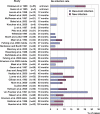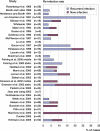Outcome of prosthesis exchange for infected knee arthroplasty: the effect of treatment approach
- PMID: 19234888
- PMCID: PMC2823239
- DOI: 10.1080/17453670902805064
Outcome of prosthesis exchange for infected knee arthroplasty: the effect of treatment approach
Abstract
Background and purpose: Two-stage revision remains the gold standard in the treatment of infected knee arthroplasty. Lately, good long-term results of direct exchange arthroplasty have been reported. The purpose of this literature review is to compare the clinical outcome achieved with one-stage revision and two-stage revision with different types of spacers.
Methods: A thorough systematic review of literature was undertaken to idenepsy reports on the treatment alternatives. Papers written in English or including an English abstract, published from 1980 through 2005, and reporting either the success rate in eradication of infection or the clinical status achieved were reviewed. 31 original articles describing the results of 154 one-stage exchange arthoplasties and of 926 two-stage exchange arthoplasties were included. The depth of detail in the description of materials and methods varied markedly, making it impossible to perform a meta-analysis. Instead, a descriptive review of the results is presented.
Results: With a follow-up of 12-122 months, the overall success rate in eradication of infection was 73-100% after one-stage revisions and 82-100% after two-stage revisions. Reinfection rates were the lowest in series where articulating cement spacers were used, though the follow-up was relatively short. Studies using articulating spacers reported the highest average postoperative ranges of motion. Otherwise, no correlations were observed between the clinical outcome and the length of follow-up, the type of revision, or the type of spacer. The clinical outcome (knee scores and range of motion) of the one-stage revisions was no different from that of the two-stage revisions.
Interpretation: Two-stage exchange is an effective treatment. Mobile spacers may further improve the range of motion. More experience in one-stage revision is required in order to define its role in the management of infected knee arthroplasties.
Figures



References
-
- Barrack RL, Butler RA, Andrews P, Rorabeck CH, Engh G. Managing the infected knee: as good as it gets. Orthopedics. 2000a;23(9):991–2. - PubMed
-
- Barrack RL, Engh GA, Rorabeck C, Sawhney J, Woolfrey M. Patient satisfaction and outcome after septic versus aseptic revision total knee arthroplasty. J Arthroplasty. 2000b;15(8):990–3. - PubMed
-
- Bengtson S, Knutson K. The infected knee arthroplasty: a 6-year follow-up of 357 cases. Acta Orthop Scand. 1991;62(4):301–11. - PubMed
-
- Booth RE, Jr, Lotke PA. The results of spacer block technique in revision of infected total knee arthroplasty. Clin Orthop. 1989;(248):57–60. - PubMed
Publication types
MeSH terms
LinkOut - more resources
Full Text Sources
Medical
